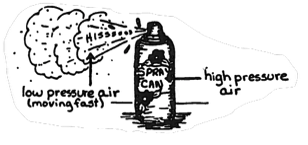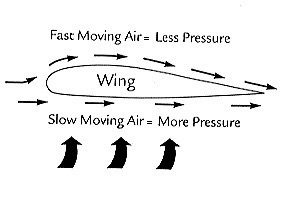Bernoulli's Principle - Air Aerodynamics Flight - Science - Grade 6

Bernoulli’s Principle: The faster air flows, the less pressure it has.
When air is moving, it creates areas of high pressure and areas of low pressure. Fast moving air creates an area of low pressure because the particles are spread further apart while high pressure air has particles packed closer together.

The top of the wing is curved. Air moves quickly over the wing. This causes Low Pressure.


The bottom of the wing is straight. Air moves more slowly. This is an area of High Pressure.
Higher pressure underneath pushes the wing up and produces lift.
The air must reach the end of the wing at the same time so the air going over the top of the wing has a longer distance to travel so it must travel faster.
Bernoulli's Principle explains the shape of an airplane's wing. The bottom is flat, while the top is curved. Air travels across the top and bottom at the same time, so air travels slower on the bottom (creating more pressure) and faster on top (creating less pressure).
Now that you understand Bernoulli’s Principle, see how it works with these interactive simulators: